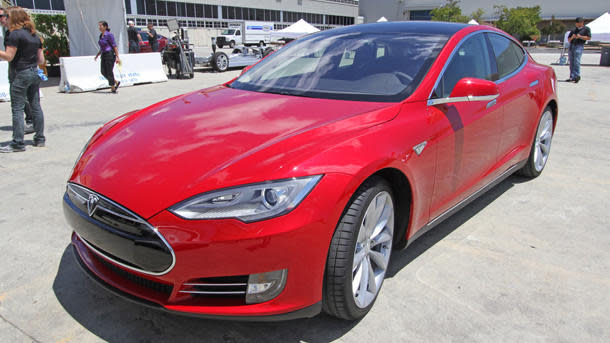 Motoramic
MotoramicTesla Model S: First drive of the electric sedan that will change the world or die trying
Of all the new cars unveiled this year, none will be as hotly anticipated as the Model S from Tesla Motors (TSLA), a luxury sedan doubling as a brash, billion-dollar bet that the era of the electric car has arrived. As the first journalist to test-drive one, I can report the Tesla Model S successfully challenges a century of assumptions about what a great car can be.
The Model S launching today from a Fremont, Calif., factory represents four years of work by Tesla engineers, fueled by $465 million in U.S. government loans and $220 million in Wall Street money (along with $50 million and the factory itself, which was originally built as a joint venture between GM and Toyota). Elon Musk, Tesla's co-founder and CEO, has vowed to make the Model S the best car in the world, and hopes to sell 20,000 a year -- at prices between $54,700 up to $105,400 -- once the factory ramps to full speed.
The last successful American startup automaker was Chrysler, founded 87 years ago. Every genius, huckster, and combination thereof who's tried since has been ground into a fine powder by massive up-front costs combined with meager profits and ruthless competition. Musk, a South African-born entrepreneur who's also founded the SpaceX rocket company, says he believes in electric cars as the necessary future of driving, and only someone with true fervor would put so much of their life into this machinery.
While the Tesla Roadster was basically a battery-operated Lotus with an electric motor, Tesla designed the Model S as an EV from the start. The all-aluminum car they've built stands as a sleek luxury sedan, a little larger than a BMW 5-Series, and from the outside there's no indication that it's electric (even the charge port is hidden behind a side reflector in the rear taillight assembly). That's by design — Tesla designer Franz von Holzhausen wanted a car that wouldn't scare buyers away. But the hints of revolution within the Model S begin with the door handles, which slide out of the body with a motorized purr when you touch them, then retract once you're behind the wheel — the kind of detail perfect for leaving valet parkers slack jawed.
I've driven a score of electric cars like the Nissan Leaf, along with serial hybrids like the Chevy Volt and Tesla's start-up competitor of sorts, the Fisker Karma, so I had some idea what to expect when Musk handed me the sleek key fob for an hour-long stint. I was wrong: The Tesla Model S drives like none of them, or any gas-powered vehicle ever built.
GEORGE JETSON, YOUR RIDE HAS ARRIVED
The first sight that greets you behind the wheel is a 17-inch touchscreen that fills the dash, eliminating almost all the buttons and knobs that clutter up most car interiors, one of the ways in which Elon Musk compares with Steve Jobs. Fed by a cellular data connection, the screen divides itself into zones for different functions — keeping the music player separate from the climate controls and the Google Maps navigation, for instance — and responds as quickly as an iPad to inputs. The graphics carry enough heft to be seen in your peripheral vision, but there will be questions about whether Tesla's reducing distractions or super-sizing them.
On the road, the Model S rewires what you expect when your foot touches the pedals. Unlike gas engines, electric cars generate their maximum power at start -- and no electric car has ever had as much power as the Model S, whose Performance edition is good for 417 hp. The zero-to-60 mph run ticks by in an impressive 4.4 seconds (5.9 seconds for the 362 hp edition), and the thrust from the instant you mash the accelerator pushes back like Alec Baldwin at a paparazzi convention.

 Yahoo Autos
Yahoo Autos 

